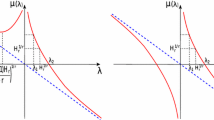Abstract
A classical result of T. Takahashi [8] is generalized to the case of hypersurfaces in the Euclidean space E m. More concretely, we classify Euclidean hypersurfaces whose coordinate functions in E m are eigenfunctions of their Laplacian.
Similar content being viewed by others
References
Barbosa, J. L. and DoCarmo, M. P., ‘Helicoids, catenoids, and minimal hypersurfaces of R n invariant by a 1-parameter group of motions’, Ann. Acad. Brasil, Ciênc. 53 (1981), 403–408.
Blair, D. E. and Vanstone, J. R., ‘A generalization of the helicoid’ in Minimal Submanifolds and Geodesics, Kadai Publications, Tokyo, 1978, pp. 13–16.
Chen, B.-Y., Total Mean Curvature and Submanifolds of Finite Type, World Scientific, Singapore and New Jersey, 1984.
Chen, B.-Y., ‘Finite submanifolds and generalizations’, Univ. of Rome, 1985.
Chen, B.-Y., ‘Surfaces of finite type in Euclidean 3-space’, Bull. Math. Soc. Belg. 39 (1987), 243–254.
Chen, B.-Y., ‘Null 2-type surfaces in E 3, Kodai Math. J. 11 (1988), 295–299.
Garay, O. J., ‘On a certain class of finite type surfaces of revolution’, Kodai Math. J. 11 (1988), 25–31.
Takahashi, T., ‘Minimal immersion of Riemannian manifolds’, J. Math. Soc. Japan. 18 (1966), 380–385.
Author information
Authors and Affiliations
Additional information
Partially supported by a CAICYT Grant PR84-1242-C02-02 Spain.
Rights and permissions
About this article
Cite this article
Garay, O.J. An extension of Takahashi's theorem. Geom Dedicata 34, 105–112 (1990). https://doi.org/10.1007/BF00147319
Received:
Issue Date:
DOI: https://doi.org/10.1007/BF00147319



